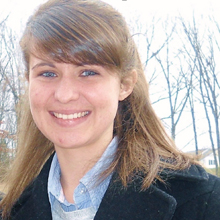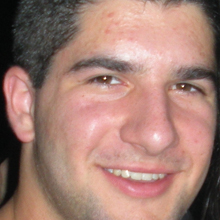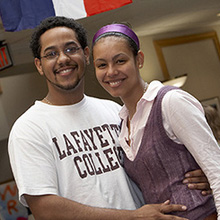After Graduation

The possibilities for further study are seemingly endless with a neuroscience major which prepares students for technical positions in research, both in an academic setting (e.g. Mt. Sinai) and in industry (e.g. pharmaceutical companies). Many have gone on to medical school at places such as Stanford University, Albert Einstein Medical College, University of Pennsylvania, Syracuse University, Penn State University, Albany Medical College, Tufts University, Drexel University, UMDNJ, and NYCOM. Some took their career path toward dental school at UMDNJ and the University of Maryland-Baltimore, and veterinary school at Northwestern University.
Others, still, opted for graduate school in public health at Harvard University, Columbia University, Johns Hopkins University, Indiana University, and Allegheny University of the Health Science. Aspiring researchers and teachers have enrolled in Ph.D. programs in neuroscience in a number of places such as Columbia University, Emory University, University of Virginia, Brown University, University of Pittsburgh, and University of Maryland-Baltimore, and Ph.D. programs in pharmacology at Columbia University, Thomas Jefferson University, Cornell-Weill, and Boston University. Former neuroscience majors have enrolled in nursing school (John Hopkins), gone on to study occupational therapy (Columbia, Thomas Jefferson), and physician’s assistant programs. Some students have even taken a slightly more unorthodox path, opting for master’s programs in creative writing and bioterrorism, both at Johns Hopkins University.
 The interdisciplinary approach of a Lafayette education and the neuroscience program more than amply prepared Stephanie Fosbenner ’10 for her current trajectory: a master’s in public health at Harvard to be followed by medical school.
The interdisciplinary approach of a Lafayette education and the neuroscience program more than amply prepared Stephanie Fosbenner ’10 for her current trajectory: a master’s in public health at Harvard to be followed by medical school.
Fosbenner notes, “Solving public health problems mandates collaboration between professionals in seemingly unrelated fields, including biomedicine, engineering, and anthropology. I had the opportunity to collaborate on research projects that involved professors from departments across campus.”
An active participant in Lafayette’s Alternative School Break, Fosbenner decided to volunteer for two months at a hospital in Tanzania. There, she found her calling to bring primary care medicine to underserved populations. Public health requires the physician to think beyond the knowledge of treating an illness from a physiological standpoint. “One must understand the complex social forces, such as poverty and discrimination, that adversely impact health.” Fosbenner says her research and volunteer experiences showed her “the value of interdisciplinary collaboration in solving real-world problems.”
 A love of science and a passion for helping others meant that a career in medicine seemed like a foregone conclusion for Jesse Hatgis ’08. “Everything I did was well-planned from a very early age in the hopes of giving myself the proper resources necessary to attain this goal. This included attending Lafayette.” Once he arrived, he found “such an academically nurturing environment, especially the neuroscience faculty.”
A love of science and a passion for helping others meant that a career in medicine seemed like a foregone conclusion for Jesse Hatgis ’08. “Everything I did was well-planned from a very early age in the hopes of giving myself the proper resources necessary to attain this goal. This included attending Lafayette.” Once he arrived, he found “such an academically nurturing environment, especially the neuroscience faculty.”
Currently, Hatgis is a third-year medical student at the New York College of Osteopathic Medicine, studying to be come a physiatrist—a physical medicine and rehabilitation doctor. He says attending Lafayette may have been the “finest” decision he has ever made. “The facilities are second to none and the EXCEL research program gave me a rich research experience that is extremely rare to have in an undergraduate setting. The class sizes are not large as in most other colleges/universities, so it is difficult to just be considered another number. Individual attention is an everyday occurrence.”
 Silvia Mancebo ’07 enrolled at Lafayette College as a Posse Foundation Scholar and wasn’t sure if she wanted to attend medical school. Nevertheless, she says she was “very focused on fulfilling the premed requirements.” In the process, she learned that she liked public health. The pivotal discovery led her to work after graduation as a research assistant in a large public health study that looked at the effects of vision loss on older people. “Working for a few years helped solidify my decision to attend medical school because I realized that even though I really enjoyed clinical research, I enjoyed much more working in a team and having one-on-one interactions with patients.”
Silvia Mancebo ’07 enrolled at Lafayette College as a Posse Foundation Scholar and wasn’t sure if she wanted to attend medical school. Nevertheless, she says she was “very focused on fulfilling the premed requirements.” In the process, she learned that she liked public health. The pivotal discovery led her to work after graduation as a research assistant in a large public health study that looked at the effects of vision loss on older people. “Working for a few years helped solidify my decision to attend medical school because I realized that even though I really enjoyed clinical research, I enjoyed much more working in a team and having one-on-one interactions with patients.”
Now, as a medical student at SUNY-Downstate in Brooklyn, the New York native reflects on her time at Lafayette. “The professors did their best to make sure that we walked out of a course with a solid foundation for the next level.” Beyond the classroom, she cherishes the relationships she formed, a unique aspect of Lafayette. “I can say that I developed a long-lasting bond with many of my professors.”